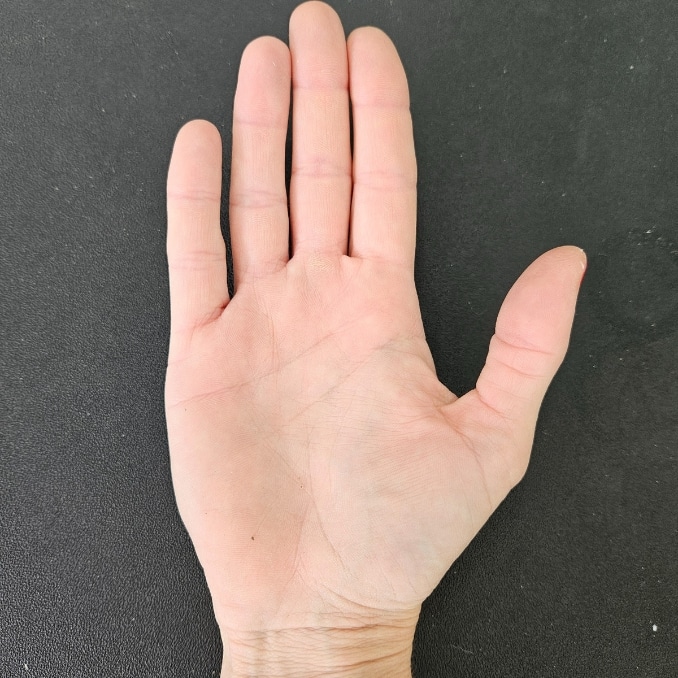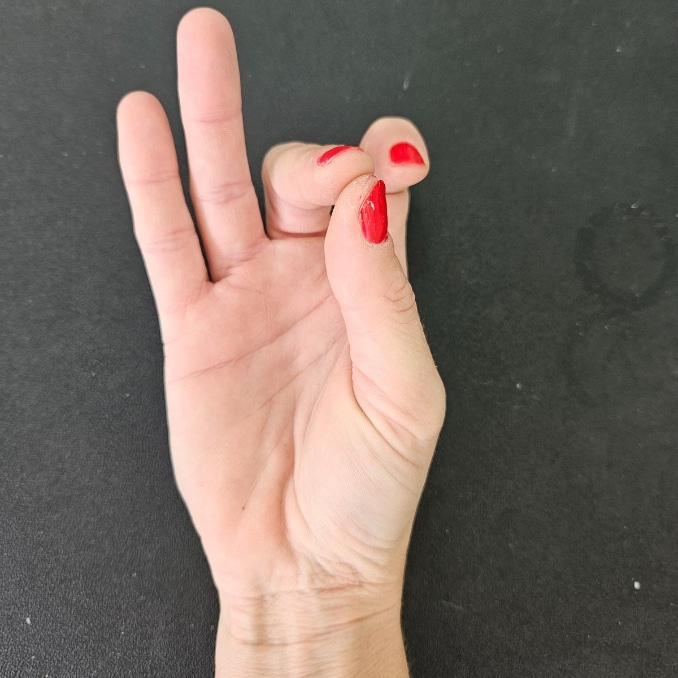Tired of fumbling with jar lids or experiencing thumb pain that limits your activities? Don't underestimate the importance of strong, flexible thumbs! This comprehensive thumb strengthening exercises guide empowers you, whether you're an athlete seeking a superior grip or looking to improve hand function and reduce discomfort.
We'll delve into practical thumb exercises targeting the key muscles responsible for movement and control. From gentle stretches to resistance training techniques, you'll discover a range of exercises designed to enhance thumb strength and flexibility.
Get ready to unlock the full potential of your hands and experience the benefits of incorporating thumb-strengthening exercises into your daily routine.
Understanding Thumb Function: Key to Hand Strength and Precision

The thumb is a critical part of the human hand, crucial in our ability to grasp and manipulate objects. The thumb is the only digit opposing the other fingers, allowing for precision and strength. Its anatomy consists of two phalanges, a metacarpal bone, and a complex network of ligaments and tendons.
This unique structure [1] enables the thumb to move in multiple directions and generate significant force. Thumb and little finger strength are directly related to their anatomy and the coordination of muscles and tendons.
Strong, opposable thumbs are crucial for our ability to interact with the world around us. They provide the power grip [2] to lift heavy objects, like groceries or furniture. But their dexterity goes far beyond that. The delicate movements of the thumb in coordination with our fingers allow us to perform fine motor skills.
From threading a needle with pinpoint accuracy to meticulously arranging miniature figurines, our thumbs enable the intricate control needed for tasks that demand precision. Even simple actions like turning a doorknob or manipulating a zipper rely heavily on the strength and flexibility of the thumb.
Importance of Thumb Strength
Thumb strength is vital for everyday activities, impacting our ability to grip, pinch, and grasp objects effectively. Strong thumb muscles enable precise control in tasks such as using tools, playing sports, and typing, helping to maintain a firm grip and manipulate objects efficiently.
Additionally, adequate thumb strength is crucial for preserving dexterity and preventing injuries like strains or repetitive motion disorders. Therefore, including exercises that target the thumb muscles in regular fitness routines is essential for maintaining optimal thumb strength and overall hand functionality.
How to Strengthen Thumb Muscles

Improving the strength and skill of your thumb muscles is essential for various daily tasks and activities. Below are some general ideas and concepts to guide you in strengthening your thumb muscles.
- Resistance Activities: Engage in activities that naturally provide resistance to your thumbs, such as squeezing a stress ball or clay.
- Thumb Opposition Movements: Practice bringing your thumb in contact with each finger individually and sequentially to enhance coordination and strength.
- Object Manipulation: Incorporate various objects of different shapes and sizes for manipulation, like rolling small things between your thumb and finger joints.
- Grip and Release Exercises: Focus on gripping and releasing motions to challenge your thumb joints and muscles. This can include holding onto objects and then letting them go.
- Stretching and Flexibility: Include gentle stretching movements to improve the flexibility of your thumb muscles. This can be achieved through controlled thumb movements and stretches.
- Hand Resistance Tools: Use hand resistance tools, such as a soft elastic band or putty, finger stretchers, and grip strengtheners, to create resistance for your thumb movements.
- Functional Tasks: Incorporate thumb exercises into your daily activities, like opening jars, turning keys, or buttoning clothes. These practical tasks can contribute to thumb strength.
- Finger and Thumb Coordination Games: Engage in games or activities that require precise finger and thumb coordination, such as playing specific musical instruments or video games.
- Circumduction Movements: To perform circular motions, move your thumb in a controlled manner, clockwise and counterclockwise.
- Isometric Contractions: Practice isometric contractions by gently pressing your thumb against your other fingers or an immovable flat surface, holding the position briefly, and then releasing it.
Benefits of Thumb Strengthening Exercises

Thumb-strengthening exercises are a crucial component of a comprehensive fitness regimen, offering many benefits beyond the basic enhancement of grip strength.
This section delves into the holistic advantages of these exercises, demonstrating how they contribute to overall hand functionality and well-being. Here’s a closer look at the key benefits:
- Enhanced Grip Strength: Improves the ability to handle sports equipment, tools, and daily tasks like opening jars.
- Improved Hand Endurance: Increases the stamina of hand muscles, beneficial for activities that require prolonged hand use.
- Reduced Thumb and Hand Injury Risk: It stabilizes the thumb joint and reduces strain, decreasing the likelihood of sprains and repetitive strain injuries.
- Enhanced Hand-Eye Coordination: Boosts coordination and dexterity, which is important for sports and everyday activities requiring precise movements.
- Improved Fine Motor Skills: This enhances the coordination of small muscle movements, which is critical for detailed tasks like writing or sewing.
- Potential Relief from Arthritis and Carpal Tunnel Syndrome: Helps manage pain and improve function in hand mobility and comfort conditions.
- Increased Overall Hand Functionality: Strengthening the hand improves the ability to perform various actions such as pushing, pulling, and lifting.
By incorporating thumb-strengthening exercises into a regular fitness regimen, individuals can expect significant improvements in hand health and performance.
This section aims to motivate readers to recognize the importance of thumb strength and encourage them to integrate these exercises into their fitness routines to reap the diverse benefits.
Common Thumb Injuries and Conditions
Thumb injuries and conditions can range from mild to severe and often stem from trauma, repetitive use, or existing health issues.
Strengthening the thumb through specific exercises can significantly mitigate the risk of such injuries. Stronger muscles around the thumb provide better support and stability, reducing the likelihood of strains and sprains.
This reinforcement helps cushion the thumb against impacts and lessens the wear on joints and tendons, which can be particularly beneficial for preventing conditions exacerbated by repetitive movements. A robust thumb is less susceptible to injuries, emphasizing the importance of regular thumb-strengthening exercises in maintaining hand health.
Here are some common thumb injuries and conditions:
- Sprained Thumb
- Thumb Fracture
- Trigger Thumb (Stenosing Tenosynovitis)
- De Quervain's Tenosynovitis
- Gamekeeper's Thumb (Skier's Thumb)
- Hand Arthritis
- Thumb Tendonitis
- Carpometacarpal (CMC) Joint Sprain
- Thumb Ligament Injury
- Ganglion Cyst
Strengthening exercises can help prevent future thumb injuries, particularly for those involved in activities that place significant stress on the thumb joint. By building stronger muscles and enhancing joint stability, these exercises reduce the risk of common issues such as sprains and strains.
However, it is important to seek medical attention for persistent or severe thumb pain, swelling, or any loss of function, as these symptoms may indicate a more serious condition requiring professional care.
Treatment may include rest, splinting, physical therapy, medication, or, in extreme cases, surgical intervention. Always consult with a healthcare professional for an accurate diagnosis and appropriate management.
1. Thumb Opposition Exercise
You can do this hand movement either in a standing or seated position.
Place your hand on a table or any other flat surface with your hand flat and open, fingers straight, and palm facing up. Touch the tip of your thumb to the tip of each finger sequentially—index finger, middle, ring, and pinky finger. After touching each finger, reverse the motion, bringing your thumb back to its original starting position. Switch hands and repeat this opposition movement for 10-12 repetitions.
 |
 |
 |
 |
 |
 |
2. Thumb Squeeze with a Soft Ball
Begin in an upright sitting position on a chair with your feet shoulder-width apart, maintaining a good alignment with your head, shoulder, and hips. Hold a soft ball in your palm, placing your thumb on one side and fingers on the other like a gentle fist. Squeeze the ball with your thumb and fingers, maintaining the pressure for a few seconds. Slowly release the pressure. Repeat for 10-15 squeezes on each hand.

3. Thumb Abduction and Adduction
You can do this hand movement either in a standing or seated position.
Extend your arms forward with an open hand and extended fingers. Move your thumb away from your fingers as far as comfortably possible, making your thumb pointing outside. Bring your thumb back towards your fingers. Perform 10-12 repetitions in each direction on both hands.
 |
 |
4. Thumb Extension/ Thumb flexion
You can do this hand movement either in a standing or seated position.
Extend your arms on the side with an open hand and extended fingers. Bend your thumb inward, bringing it towards the base of the palm and your fingers. Extend your thumb, moving it away from your fingers. Repeat for 12-15 reps on each hand.
 |
 |
5. Thumb Circle Exercise
You can do this hand movement either in a standing or seated position.
Extend your arms to the side, hand open, fingers extended. Rotate your thumb clockwise. Reverse the motion and rotate your thumb counterclockwise. Perform 8-10 circles in each direction on both hands.
 |
 |
 |
 |
Hand Exercise at Home

Here's a simple hand exercise routine that you can do at home. These hand exercises are designed to help improve flexibility and strength in your hands:
- Finger Taps
- Finger Stretch
- Fist to Fan
- Wrist Flexor Stretch
- Thumb Touch
- Wrist Circles
- Finger Squeeze
- Wrist Extension
Remember to perform these exercises slowly and gently, especially if you have any existing hand or wrist conditions. If you experience pain or discomfort, stop the exercise and consult with a healthcare professional.
Incorporating Thumb-Strengthening Exercises into Your Routine
Integrating thumb-strengthening exercises into your daily routine can significantly enhance hand functionality and prevent common issues. Here’s how to effectively include these exercises:
- Identify Convenient Times: Incorporate thumb exercises during downtime, such as watching TV, sitting at your desk, or during breaks.
- Start with Simple Movements: Begin with basic exercises like thumb opposition, where you touch the tip of your thumb to each fingertip. Perform this slowly, controlled to improve muscle coordination and strength.
- Progress to More Challenging Exercises: As you build strength, incorporate more demanding exercises such as thumb abduction. Spread your thumb away from your fingers as far as comfortable, hold for a few seconds, and then relax.
- Use Tools if Necessary: Employ small resistance tools, such as stress balls or grip strengtheners, to provide additional resistance and enhance muscle building.
- Consistency is Key: To see improvements in strength and dexterity, aim to perform these exercises regularly, ideally daily.
- Monitor Progress and Adjust: Pay attention to grip and overall hand function improvements. If exercises become too easy, increase the difficulty or duration.
By regularly practicing these exercises, thumb strength can be maintained or improved. Thumb strength is crucial for effective hand use in daily activities and preventing conditions like arthritis and carpal tunnel.
Conclusion
In conclusion, mastering thumb-strengthening exercises is crucial for enhancing hand strength and overall dexterity. The thumb is vital in most everyday activities, from gripping objects to performing intricate tasks.
By engaging in regular thumb-strengthening exercises, individuals can improve their hand grip, increase their thumb's range of motion, and reduce the risk of injury. These exercises include thumb stretches, resistance training with hand grips or therapy putty, and specialized tools like thumb exercisers or stress balls.
Incorporating these exercises into a regular hand-strengthening routine can significantly improve hand strength and overall performance in various activities.
Discover how to naturally strengthen and protect your bones! Check out this 14-Day Bone Strengthening Quick Start Program now!





